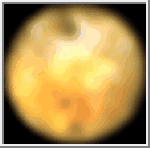|
COMETS EARTH JUPITER KUIPER BELT MARS MERCURY METEORITES NEPTUNE OORT CLOUD PLUTO SATURN SOLAR SYSTEM SPACE SUN URANUS VENUS ORDER PRINTS
PHOTO CATEGORIES SCIENCEVIEWS AMERICAN INDIAN AMPHIBIANS BIRDS BUGS FINE ART FOSSILS THE ISLANDS HISTORICAL PHOTOS MAMMALS OTHER PARKS PLANTS RELIGIOUS REPTILES SCIENCEVIEWS PRINTS
|
Related Document
Download Options
This picture is a composite of a black and white near infrared image of Jupiter and its satellite Io and a color image of Io at shorter wavelengths taken at almost the same time on March 5, 1994. These are the first images of a giant planet or its satellites taken by NASA's Hubble Space Telescope (HST) since the repair mission in December 1993. Io is too small for ground-based telescopes to see the surface details. The moon's angular diameter of one arc second is at the resolution limit of ground based telescopes. Many of these markings correspond to volcanoes that were first revealed in 1979 during the Voyager spacecraft flyby of Jupiter. Several of the volcanoes periodically are active because Io is heated by tides raised by Jupiter's powerful gravity. The volcano Pele appears as a dark spot surrounded by an irregular orange oval in the lower part of the image. The orange material has been ejected from the volcano and spread over a huge area. Though the volcano was first discovered by Voyager, the distinctive orange color of the volcanic deposits is a new discovery in these HST images. (Voyager missed it because its cameras were not sensitive to the near-infrared wavelengths where the color is apparent). The sulfur and sulfur dioxide that probably dominate Io's surface composition cannot produce this orange color, so the Pele volcano must be generating material with a more unusual composition, possibly rich in sodium. The Jupiter image, taken in near-infrared light, was obtained with HST's Wide Field and Planetary Camera in wide field mode. High altitude ammonia crystal clouds are bright in this image because they reflect infrared light before it is absorbed by methane in Jupiter's atmosphere. The most prominent feature is the Great Red Spot, which is conspicuous because of its high clouds. A cap of high-altitude haze appears at Jupiter's south pole. The Wide Field/Planetary Camera 2 was developed by the Jet Propulsion Laboratory and managed by the Goddard Spaced Flight Center for NASA's Office of Space Science. (Credit: John Spencer, Lowell Observatory; NASA) |
